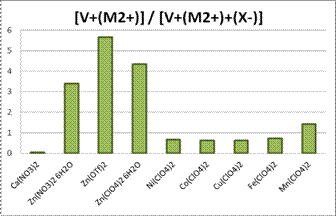57th Annual Report on Research 2012 Under Sponsorship of the ACS Petroleum Research Fund
Reports: UR650147-UR6: Understanding the Role of Metal Ions in Mass Spectrometric Ionization Processes: Experimental and Computational Studies
Farooq A. Khan, PhD, University of West Georgia
The proposal is based on computational and experimental studies of binding of metal ions to synthetic organic compounds that serve as matrices in MALDI experiments. With permission from the Program Officer, the mass spectral studies were extended to include electrospray ionization mass spectrometry (ESI-MS).
During the preceding year, the formation of adducts of a variety of compounds including MALDI matrices and alkali and alkaline earth metal ions were studied. Both computational and experimental approaches were used, namely DFT calculations using the software Gaussian 09 and ESI-MS techniques. The results from these studies are at present preliminary, and will be reported in future.
During ESI-MS studies carried out in 2009-2011, a serendipitous discovery was made that the ionophore valinomycin, well known for its cation binding properties, also binds directly to anions. This avenue was explored both experimentally and computationally, resulting in a publication in the journal Supramolecular Chemistry. This work was carried out in collaboration with Professor Megumi Fujita (Department of Chemistry), a former recipient of an ACS-PRF grant, and Professor Swamy Mruthinti (Department of Biology) and five undergraduate students.
While exploring the binding of valinomycin with doubly charged cations using ESI-MS during 2011-2012, another serendipitous discovery was made that valinomycin (V) simultaneously binds to doubly charged cations (M2+) and singly charged anions (X-). This discovery has an important bearing in the area of supramolecular chemistry, wherein syntheses of compounds that simultaneously bind cations and anions are of immense interest. A summary of results is shown below, in the form of the ratio of ESI-MS intensities of V.M2+ and V.M2+X-.
Additional experiments and computational studies are in progress. The computations using Gaussian 09 are facile, but immensely time-consuming, and are expected to yield publishable results.











